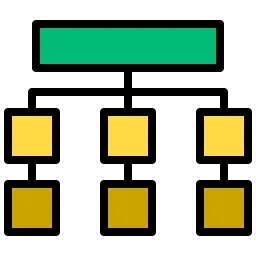0
Notifications Mark All Read
- Login
- Get Prime
What is Hybrid Inheritance in C++
Hybrid or Multipath Inheritance in C++
On this page we will discuss about hybrid inheritance in C++ . As we know that inheritance is the process of extending the source code of one class to another class . It’s interesting to know that we can have the combination of both multilevel and Hierarchical Inheritance . This type of inheritance is also known as Multipath or Hybrid Inheritance
Syntax to Implement Hybrid Inheritance in C++
- The class that is acquiring the behaviors is called child class or derived class or subclass
- The class from which behaviors are taken is called parent class or superclass or base class
class parent
{
----;
};
class child1: access parent
{
-----;
//contains properties of both
//parent+child1
};
class child2: access parent
{
----;
//contains properties of both
//parent+child2
};
class child2_1: access child2
{
-----;
//contains properties of both
//parent+child2+child2_1
};
class child1_1:access child1
{
-----;
//contains properties of both
//parent+child2+child1_1
};
Example: Program to demonstrate hybrid inheritance
Run
#include <iostream>
using namespace std;
class A
{
public:
void m1()
{
cout<<"\n m1 from class A";
}
};
class B: public A//B class inherits A as Parent
{
public:
void m2()
{
cout<<"\n m2 from class B";
}
//contains data of A+B
};
class C: public A//C class inherits A as Parent
{
public:
void m3()
{
cout<<"\n m3 from class C"; } //Contains data of A+C }; class D:public B//multilevel inheritance from A->B->D
{
public:
void m4()
{
cout<<"\n m4 from class D"; } //contains data of class A+B+D }; class E:public C//multilevel inheritance from A->C->E
{
public:
void m5()
{
cout<<"\n m5 from class E";
}
//contains data of class A+C+E
};
main()
{
D d;//contains A+B+D properties
d.m1();
d.m2();
d.m4();
E e;//contains A+C+E properties
e.m1();
e.m3();
e.m5();
}
Output:
m1 from class A m2 from class B m4 from class D m1 from class A m3 from class C m5 from class E
Hierarchal Inheritance from A-B and A-C
- Class B contains 2 methods m1() from class A and m2() by its own
- Class C contains 2 methods m1() from class A and m3() by its own
Multilevel inheritance from class A-B-D and A-C-E
- Class D contains 3 methods m1() from class A and m2() from class B and its own method m4()
- Class E contains 3 methods m1() from class A and m3() from class C and its own method m5()
Prime Course Trailer
Related Banners
Get PrepInsta Prime & get Access to all 200+ courses offered by PrepInsta in One Subscription
Get over 200+ course One Subscription
Courses like AI/ML, Cloud Computing, Ethical Hacking, C, C++, Java, Python, DSA (All Languages), Competitive Coding (All Languages), TCS, Infosys, Wipro, Amazon, DBMS, SQL and others

 0
0



Login/Signup to comment